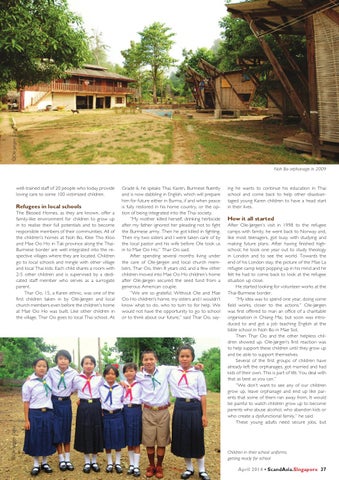©Ole-Jørgen Edna
Noh Bo orphanage in 2009
well-trained staff of 20 people who today provide loving care to some 100 victimized children.
Refugees in local schools
©Ole-Jørgen Edna
The Blessed Homes, as they are known, offer a family-like environment for children to grow up in to realise their full potentials and to become responsible members of their communities. All of the children’s homes at Noh Bo, Klee Tho Kloo and Mae Oo Ho in Tak province along the ThaiBurmese border are well integrated into the respective villages where they are located. Children go to local schools and mingle with other village and local Thai kids. Each child shares a room with 2-5 other children and is supervised by a dedicated staff member who serves as a surrogate parent. Thar Oo, 15, a Karen ethnic, was one of the first children taken in by Ole-Jørgen and local church members even before the children’s home at Mae Oo Ho was built. Like other children in the village, Thar Oo goes to local Thai school. At
Grade 6, he speaks Thai, Karen, Burmese fluently and is now dabbling in English, which will prepare him for future either in Burma, if and when peace is fully restored in his home country, or the option of being integrated into the Thai society. “My mother killed herself, drinking herbicide after my father ignored her pleading not to fight the Burmese army. Then he got killed in fighting. Then my two sisters and I were taken care of by the local pastor and his wife before Ole took us in to Mae Oo Ho,” Thar Oo said. After spending several months living under the care of Ole-Jørgen and local church members, Thar Oo, then 8 years old, and a few other children moved into Mae Oo Ho children’s home after Ole-Jørgen secured the seed fund from a generous American couple. “We are so grateful. Without Ole and Mae Oo Ho children’s home, my sisters and I wouldn’t know what to do, who to turn to for help. We would not have the opportunity to go to school or to think about our future,” said Thar Oo, say-
ing he wants to continue his education in Thai school and come back to help other disadvantaged young Karen children to have a head start in their lives.
How it all started After Ole-Jørgen’s visit in 1998 to the refugee camps with family, he went back to Norway and, like most teenagers, got busy with studying and making future plans. After having finished highschool, he took one year out to study theology in London and to see the world. Towards the end of his London stay, the picture of the Mae La refugee camp kept popping up in his mind and he felt he had to come back to look at the refugee situation up close. He started looking for volunteer works at the Thai-Burmese border. “My idea was to spend one year, doing some field works, closer to the actions.” Ole-Jørgen was first offered to man an office of a charitable organisation in Chiang Mai, but soon was introduced to and got a job teaching English at the bible school in Noh Bo in Mae Sot. Then Thar Oo and the other helpless children showed up. Ole-Jørgen’s first reaction was to help support these children until they grow up and be able to support themselves. Several of the first groups of children have already left the orphanages, got married and had kids of their own. This is part of life. You deal with that as best as you can.” “We don’t want to see any of our children grow up, leave orphanage and end up like parents that some of them ran away from. It would be painful to watch children grow up to become parents who abuse alcohol, who abandon kids or who create a dysfunctional family,” he said. These young adults need secure jobs, but
Children in their school uniforms getting ready for school April 2014 • ScandAsia.Singapore 37
